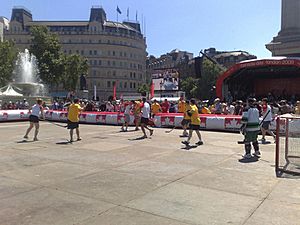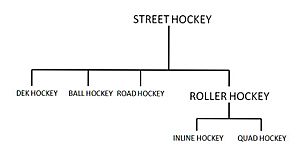Street hockey facts for kids

People playing street hockey in an outdoor rink.
|
|
| Highest governing body | International Street and Ball Hockey Federation (International) World Ball Hockey Federation (international) Canadian Ball Hockey Association (Canada) |
|---|---|
| Nicknames | United States = ball hockey, dek hockey / Canada, Europe, Asia = ball hockey (some parts of Canada call it "road" hockey) |
| First played | Fitchburg |
| Characteristics | |
| Type | Primarily outdoor, indoor |
| Equipment | Required = A ball or a puck (most players use a ball but a small percentage use a puck), a hockey stick, a net. Optional = shin pads, gloves, helmet. |
Street hockey is a fun sport similar to ice hockey, but it's played without ice! You can play it outdoors on foot, or with inline skates or roller skates. Instead of an ice puck, players usually use a special ball or a street hockey puck. The main goal is simple: score more goals than the other team by shooting the ball or puck into their net.
When people play street hockey just for fun, without a league, they often follow these simple rules:
- Players try not to touch each other too much to stay safe.
- Most players don't wear a lot of protective gear.
- Players decide together if they will allow hard shots or raising their sticks high. These can be dangerous without proper gear.
- They choose if they want to use a street hockey ball, a tennis ball, or a special puck.
- Usually, there isn't a referee unless everyone agrees to have one.
Street hockey is often played outside on surfaces like streets, parking lots, or tennis courts. This is why it's called "street" hockey! Teams can be picked in different ways. Sometimes captains choose players, or everyone puts their sticks in a pile and they are sorted into two teams. More organized games happen in special rinks, which can be indoors or outdoors. These rinks are sometimes called "dek hockey" or "ball hockey" rinks.
Contents
How to Play Street Hockey
Street hockey is a lot like ice hockey. The main idea is to score goals by hitting the ball or puck into the opponent's net. It's generally safer than ice hockey because there are no sharp skate blades or hard body checks. Players usually play on foot on surfaces like asphalt or cement.
The most popular balls are orange plastic ones made for street hockey. Tennis balls are also used. Pucks are not used as often because of the playing surface. However, some special pucks with bearings can be used for roller hockey. If a puck is used, players usually agree to keep it on the ground. This is because players often don't wear helmets, and a puck hitting someone's head could cause a serious injury. Since players commonly use a water-filled ball, it is less dangerous than using a hard rubber puck.
Because players usually wear little to no protective gear, rough physical contact is usually not allowed. The game allows a similar level of physical contact to what you might see in a basketball game.
Starting the Game
Rules can change depending on where you play. In informal games, the game often starts in one of two ways:
- The two players in the middle hit their sticks together three times, saying "N," "H," "L." After the "L," they try to get the ball first.
- One team simply starts with the ball from behind their own net, like in basketball after a score.
Different Names for Street Hockey
When street hockey is played in rinks, it's often called "dek hockey" or "ball hockey." The name depends on where you are in the U.S. or Canada. Most people call it ball hockey, but some parts of America prefer "dek hockey."
Dek hockey and ball hockey usually follow organized rules. This is especially true if they are part of an official league. So, if you say you're playing dek hockey or ball hockey, it means you're playing by a specific set of rules.
Street hockey can also be played indoors on basketball courts or in gyms. This type of game is called floor hockey. Organized floor hockey leagues often have slightly different rules from outdoor street hockey. The walls or fences of these indoor rinks help keep the ball in play, just like the boards in an ice rink.
Understanding the Terms
The different names for street hockey can be a bit confusing. But it's actually quite simple:
- Street hockey has variations like dek hockey, ball hockey, and roller hockey.
- Dek hockey got its name from the special floor material, called "the dek," used in indoor and outdoor rinks.
- Ball hockey got its name when leagues started using a ball instead of a puck. This helped players know what kind of game they were joining.
There are some differences between dek hockey and ball hockey rules. These differences mostly matter in official tournaments.
Dek Hockey Rules
- The center line is the offsides line.
- You cannot raise your stick above your shoulder unless you are shooting or moving around another player.
- You cannot close your hand around the ball.
- Official rink sizes are at least 160 feet long by 80 feet wide.
Ball Hockey Rules
- Offside is determined by a "floating blue line." This means when the ball crosses the blue line, the attacking team is onside. They can use the whole zone up to the center line. Once the ball crosses the center red line, players must clear the defending team's blue line and have the ball enter past the blue line to be onside again.
- You can raise your stick above your shoulder to ask for a pass.
- You can close your hand around the ball if you bring it straight down to your feet and don't change your direction.
- International rink sizes are 197 feet by 98.4 feet.
- North American rink sizes are 200 feet by 85 feet.
New Places to Play
In Canada, playing in outdoor lacrosse boxes is becoming popular. These boxes have asphalt surfaces like streets, but they are larger and have boards around them. This makes the game feel more like real hockey. Players also don't have to worry about cars or people walking by.
In the United States, outdoor rinks are also becoming popular in public areas. These rinks provide a safe place to play away from busy streets. Many outdoor rinks have a special plastic tile surface, which helps equipment last longer than on asphalt. Some are concrete with special paint for good grip. Many rinks are also covered for play in wet weather and have lights for nighttime games. There are also many indoor rinks in Canada and the United States.
Street Hockey Equipment
Street hockey equipment is similar to ice hockey gear, but it's lighter and more flexible. Since body checks are not allowed, you don't need all the heavy protective gear. In casual games, players often wear some combination of:
- Hockey gloves
- Shin guards (often like those used in soccer)
- Eye protection
- Athletic support
- Mouth guards
Goalies usually wear equipment that looks like ice hockey goalie gear. This is for safety and to help them block more of the net. However, street hockey goalie gear is lighter. This is because the ball or puck used in street hockey is not as heavy or hard as the puck used in ice hockey.
Sticks
A street hockey stick looks like an ice hockey stick. But it's made of materials that can handle playing on asphalt or other hard surfaces. It has two main parts: the shaft and the blade.
- The shaft is often made of aluminum, graphite, or wood.
- The blade is usually made of plastic. It attaches to the shaft, often with special glue or screws.
Some street hockey sticks are made as one piece from plastic, graphite, or other materials. You can also use ice hockey or inline hockey sticks. However, street hockey sticks are usually cheaper and stronger for playing on rough surfaces. In organized leagues, players often use more expensive sticks. These games are played on special surfaces that are safer and faster than concrete.
Balls
The orange "no bounce" ball is very popular for street hockey. Now, there are many different colors available for different weather conditions. For example, yellow, red, pink, and even glow-in-the-dark balls exist. Many ball makers print the best temperature range for the ball right on the package.
- Red/orange balls are for hot or warm weather (above 60 degrees Fahrenheit).
- Pink balls are for cool weather (between 40-60 degrees Fahrenheit).
- Yellow balls are for cold weather (below 40 degrees Fahrenheit).
A tennis ball or a whiffle ball can also be used. They are much softer than the orange ball, which can help reduce the risk of injury.
The International Street and Ball Hockey Federation (ISBHF) is the main group for official ball hockey tournaments. They officially approve two types of balls: a hard ball for warm weather and a softer ball for colder weather.
Street Hockey Organizations
International Groups
The International Street and Ball Hockey Federation (ISBHF) is the worldwide group that manages the sport. The International Ice Hockey Federation officially recognizes them. The ISBHF started in 1993 and has held international competitions since 1995.
North American Groups
- The Canadian Ball Hockey Association is the official group for ball hockey in Canada. The ISBHF recognizes them.
- USA Ball Hockey is the official group for street and dek hockey in the United States. The ISBHF also recognizes them.
European and Asian Groups
Many countries in Europe and Asia have their own street hockey groups. These countries have enough players to have a national presence. Their rule books are usually based on the Canadian, American, or ISBHF rules.
Street Hockey Tournaments
International Tournaments
The International Street and Ball Hockey Federation holds many international tournaments. Most of these are separated by age groups and gender. These tournaments usually happen every two years. Examples include:
- Men's and Women's tournaments for players 20 and over.
- Men's and Women's tournaments for players under 20, under 18, and under 16.
- Men's Masters Tournament for players aged 40 and over.
- Women's Masters Tournament for players aged 35 and over.
North American Tournaments
Dozens of tournaments happen across North America every year. These usually start on a Friday and end on Sunday evenings.
How Popular is Street Hockey?
The ISBHF says that street hockey leagues exist in over 60 countries around the world. It's safe to say that wherever people play ice hockey, they probably also play some form of street hockey!
See also
 In Spanish: Hockey callejero para niños
In Spanish: Hockey callejero para niños




